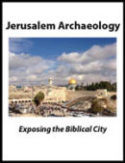
Mesha Stele. King Mesha of Moab commissioned this inscription in the ninth century BCE. It details his victories over his neighbors, including possibly the “House of David”—referencing the dynasty of King David of the Bible—in its 31st line. However, scholars Matthieu Richelle and Andrew Burlingame think the “House of David” reading cannot be confirmed. Photo: Mbzt 2012 / CC by 3.0.
The Mesha Stele and “House of David” take center stage yet again.
In the Winter 2022 issue of Biblical Archaeology Review, André Lemaire and Jean-Philippe Delorme examined the possible reference to the dynasty of King David of the Bible in the Mesha Stele, a Moabite inscription from the ninth century BCE. Their article, “Mesha’s Stele and the House of David,” explored new photographic evidence of the ancient inscription. Their consensus: the reference to the “House of David” could finally be confirmed.
Yet not everyone agreed. Scholars Matthieu Richelle and Andrew Burlingame challenged this interpretation in their article, “Set in Stone? Another Look at the Mesha Stele,” published in the Spring 2023 issue of Biblical Archaeology Review. Although they analyze the same photographic evidence of the Mesha Stele as Lemaire and Delorme, they come to a very different conclusion about the possible reference to the dynasty of King David of the Bible.
King Mesha of Moab commissioned the stela, now known as the Mesha Stele, in the ninth century BCE. He set it up in his capital, Dibon (modern Dhiban, Jordan), where it proclaimed his victories over his neighbors, including possibly the “House of David”—referring to King David of the Bible as the founder of Judah’s ruling dynasty—in its 31st line. The stela also mentions King Omri of Israel.

For a full translation of the Mesha Stela, as read by scholar André Lemaire, please see here.
The expression “House of David” (btdwd) consists of five letters: bet, taw, dalet, waw, and dalet. The first two letters (bt) mean “house of” and the last three letters (dwd) signify the personal name David. In the Mesha Stele, the letters bet (first letter) and waw (fourth letter) are clearly visible on the inscription. However, the other three letters have been damaged and are not entirely clear.
Whereas Lemaire and Delorme think that the damaged letters taw (second letter), dalet (third letter), and dalet (fifth letter) can be reconstructed thanks to the new photographic evidence, Richelle and Burlingame are less certain. They agree that the fifth letter is best read as a dalet. Yet for the other two letters, they don’t think the letters can be definitively reconstructed. They do not rule out the possibility that the phrase reads “House of David” (btdwd), but they recognize other possibilities, too.
Although Richelle and Burlingame cannot endorse the reading “House of David” in the Mesha Stele, the matter is far from set in stone. The debate over the inscription’s possible reference to the dynasty of King David of the Bible will likely continue for years to come. Stay tuned for additional posts about this topic on Bible History Daily. And explore the evidence for yourself in Matthieu Richelle and Andrew Burlingame’s article, “Set in Stone? Another Look at the Mesha Stele,” published in the Spring 2023 issue of Biblical Archaeology Review.
Read more in Bible History Daily:
The post Does the Mesha Stele Really Reference the Dynasty of King David of the Bible? first appeared on Biblical Archaeology Society.
The post Does the Mesha Stele Really Reference the Dynasty of King David of the Bible? appeared first on Biblical Archaeology Society.

0 Commentaires